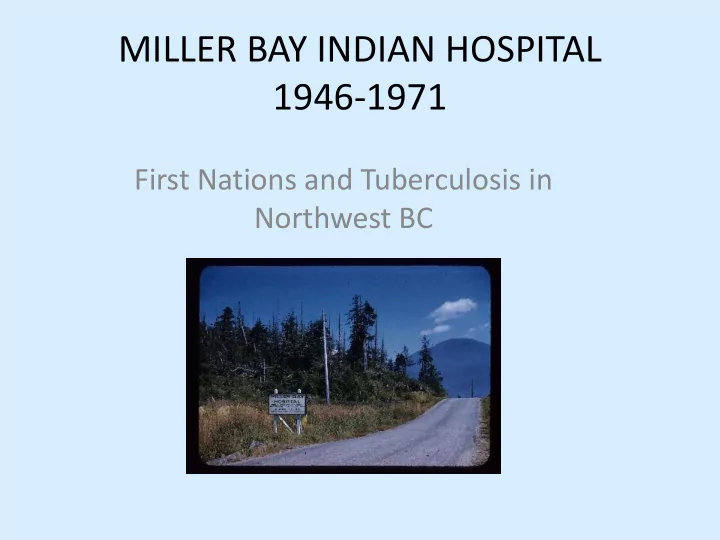

MILLER BAY INDIAN HOSPITAL 1946-1971 First Nations and Tuberculosis in Northwest BC
Started as RCAF hospital in 1944 though never used as such
Tuberculosis and Canada’s Indigenous Peoples • Evidence of TB before European contact • Effects of colonization promoted spread (overcrowding, starvation)
Contrasts in Treatment and Prevalence of TB in Canada(BC), 20 th century Non-aboriginal Aboriginal • Tranquille sanitorium • Miller Bay opened in 1946, opened in 1906, closed in closed in 1971 1958 • By 1939, TB death rate • In 1939, death rate 5-10 falling, “treatment was times higher than for non- under control” First Nations people. • Much support and publicity from service clubs, • Only funding from Indian volunteers, Canadian TB Affairs (federal government) Association
“Old Cahoose” • Dr. Galbraith in Bella Coola
Opening of “Indian Hospitals” in BC Coqualeetza—Sardis (former residential school, destroyed by fire) 1941 Miller Bay—initially for both TB and VD (STI’s) 1946 Nanaimo 1946
September 16, 1946
Hospital Layout
Treatments Before TB drugs After TB drugs appeared • Bedrest • Combinations of medications • Lung collapse • Rest depending on extent of disease: Strict rest periods • Major chest surgery observed • Shorter hospitalization needed
Miller Bay Indian Day School
Schooling at Miller Bay Bedside teaching Classroom (later) Occupational therapy—handicrafts Music: Guitar, harmonica, choir Adult education On the job training
“Irregular Discharges” • Higher rate at Miller Bay than at other 2 • More women than men • Younger age group (below 35 years) • “Coercion” and “police methods” used in early years
Patient experiences in mid-1950s • Patient and Staff survey 1954—Women’s ward • Led to staff changes, Patient’s council, newspaper produced by patients • Dr. Fiddes—change in policy re mothers and newborns
Working at Miller Bay
Accommodation
Early 1960s Educational and employment opportunities
Recreation for Staff • Recreation Hall moved from Seal Cove Airforce Base to Miller Bay –later used by patients also • Bus transportation to Prince Rupert • Families of staff—children went to school in Prince Rupert
Phasing Out and Closure • More diversified in 1960s—less TB • Became extended care facility by late 1960s; school phased out • Final closing 1971; patients transferred
1970-2015 • Used as fish farm, petting zoo, residence for mill workers • Fire destroyed buildings which were then demolished • Paintball site • Gradually disappearing under the brush
Then and Now
REFERENCES Kelm, M. (1998). Colonizing Bodies: Aboriginal Health and Healing in British Columbia 1900-50. Vancouver: UBC Press. McCuaig, K. (2002). The Weariness, the Fever, and the Fret: The Campaign Against Tuberculosis in Canada, 1900-1950. Lux, M. (2001). Medicine That Walks: Disease, Medicine, and Canadian Plains Native People, 1880-1940. University of Toronto Press.
Books on “Indian” Hospitals Meijer Drees, L. (2013). Healing Histories: Stories from Canada’s Indian Hospitals. Lux, M. (2016) Separate Beds: A History of Indian Hospitals in Canada, 1920s-1980s. Geddes, G. (2017) Medicine Unbundled: Dispatches from the Indigenous Frontlines. Harrison, C. (2017) Miller Bay Indian Hospital: Life and Work in a TB Sanatorium.
Recommend
More recommend